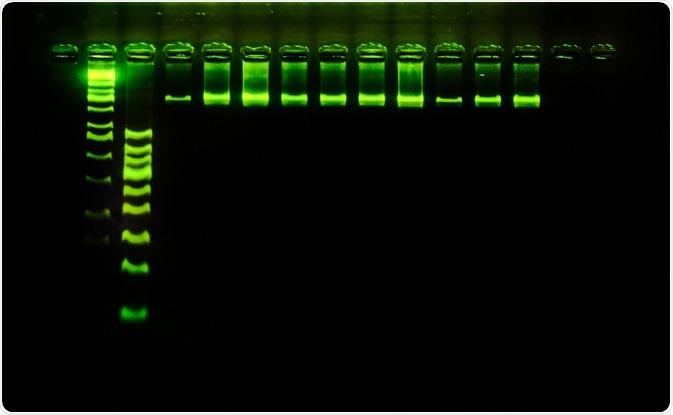What is capillary electrophoresis?
Capillary electrophoresis is a family of methods of electrokinetic separation that are used to separates ions based on their electrophoretic mobility through the use of an applied voltage. These analyses are performed in submillimeter diameter capillaries and micro and nanofluidic channels.

Image Credit: Hand Robot/Shutterstock.com
There are many methods under the umbrella term of capillary electrophoresis such as; capillary zone electrophoresis (CZE), capillary gel electrophoresis (CGE), micellar electrokinetic capillary chromatography (MEKC), capillary electrochromatography (CEC), capillary isoelectric focusing (CIEF), and capillary isotachophoresis (CITP).
While all methods possess unique processes, these all work on the same basic principle. All techniques uses an electric current to move molecules through a tube (a capillary). The electrophoretic mobility depends on the molecule’s charge, its viscosity, and the radius of its atoms. The rate of movement demonstrated by the particle reflects the applied electric field, faster mobilities the field strengths.
Only ions move with the electric field, neutral species are not impacted. If ions are of the same size, those that have greater charges will move at greater speeds. If ions are of the same charge, the smaller ones which have less friction will demonstrate a faster overall migration rate.
The method of capillary electrophoresis is more often used for its advantages of producing fast results and high-resolution separation.
Forensic applications of capillary electrophoresis
Forensic labs across the world utilize capillary electrophoresis to analyze a wide range of evidence collected from crime scenes. One of its first uses was for the analysis of explosive compounds and gunshot residues. Capillary electrophoresis is considered to be a fast, sensitive, and reliable detection method of explosives that can work with a high workload.
Micellar electrokinetic capillary chromatography (MEKC) is a reliable method for characterizing organic gunpowder components. Capillary zone electrophoresis (CZE) is also relied upon for the investigation of post-blast and gunshot residues and low levels of explosives.
Evidence from handwritten notes can provide vital information in a criminal case. While several methods are commonly used to differentiate between different inks, and to determine the characteristics of ink, capillary electrophoresis has become increasingly popular due to its advantages of requiring a small sample minimizing the destruction of the document, as well as its proven ability to distinguish between different ink types and colors.
Applications of capillary electrophoresis in pharmaceutical analysis
Since the early 1990s, capillary electrophoresis has been implemented in clinical research to analyze peptides and proteins, chiral pharmaceuticals, and other small molecule drugs. Studies have shown the technique’s use in assessing purity and structural formation.
Specific applications include generating protein and peptide “fingerprints” which is useful in several areas of pharmaceutical science. For example, it can determine target proteins, the purity of a sample, and the structure, which are essential factors in drug development.
Capillary electrophoresis is also used in chiral separations, to determine the efficacy, toxicity, and pharmacokinetic properties of racemates of chiral pharmaceuticals. This aids in the development of new drug candidates that may be safer and more effective.
The increase in popularity in small molecule drugs initially presented the challenge of developing methods sensitive enough to analyze them. Due to the small dimensions of the capillaries used in capillary electrophoresis, it is a suitable method of detecting and analyzing the extreme lower limits of small molecule drug discovery.
Biomedical applications of capillary electrophoresis
The various techniques of capillary electrophoresis are utilized in a variety of biomedical applications.
Capillary electrophoresis is used for multiple diseases that require enhanced diagnostic methods, with rapid methods of diagnosis emerging for microalbuminuria, Alzheimer’s and Parkinson’s diseases, pheochromocytoma, neuroblastoma, and urinary stone disease using the technique.
Capillary electrophoresis is successful in identifying drugs and disease markers when it is coupled with mass spectrometric detection. Recent research has developed mass spectrometry in capillary electrophoresis (CE-MS) for use in determining metabolic and biochemical profiles, proteomic profiles, urine profiles, and electrophoretic and chromatographic profiles.
Determining these profiles provides new avenues to explore for the development of new therapeutic approaches and faster and more accurate diagnostic methods.
Applications of capillary electrophoresis for industrial analysis
A range of capillary electrophoresis is used by the industrial sector to determine various analytes in a wide range of sample matrices. Capillary electrophoresis in industry is used to analyse products such as; food additives, herbicide, animal nutrition, and detergents.
In particular, CZE is used to separate and identify the small molecules existing in these types of samples. This aids product developers to design products with increased effectiveness with correct levels of enzymes, proteins, peptides, nutrients, and minimize the levels of contaminants.
Sources:
- Kartsova, L., and Bessonova, E. (2015). Biomedical applications of capillary electrophoresis. Russian Chemical Reviews, 84(8), pp.860-874. https://iopscience.iop.org/article/10.1070/RCR4492
- Rabel, S., and Stobaugh, J. (1993). Applications of capillary electrophoresis in pharmaceutical analysis. Pharmaceutical Research, 10(2), pp.171-186. https://www.ncbi.nlm.nih.gov/pubmed/8456063
- Stover, F. (1990). Applications of capillary electrophoresis for industrial analysis. Electrophoresis, 11(9), pp.750-756. https://onlinelibrary.wiley.com/doi/abs/10.1002/elps.1150110912
- Thormann, W., Molteni, S., Caslavska, J., and Schmutz, A. (1994). Clinical and forensic applications of capillary electrophoresis. Electrophoresis, 15(1), pp.3-12. https://onlinelibrary.wiley.com/doi/abs/10.1002/elps.1150150103
Further Reading
Last Updated: Jun 19, 2020